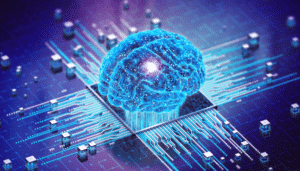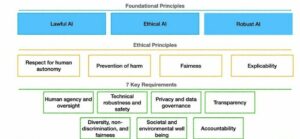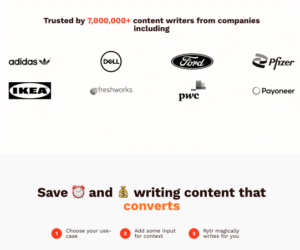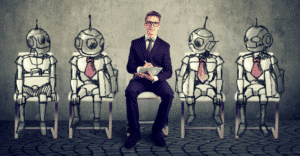
I’m going to kick things of to the world of Generative AI. Generative AI is a type of artificial intelligence technology that can produce various types of content, including text, images, audios as well as synthetic data.
This isn’t just any tech trend; it’s a transformative force reshaping how we interact with machines and how they interact with us. It’s a game changer in how new content is brought to life, from digital images to complex data models.
Evolution of Generative AI
Allow me take you on a brief retrospective journey through the evolution of Generative AI. It started off as a fledgling concept in computer science labs, with neural networks barely learning to mimic patterns. Year 2014 saw the introduction of generative adversarial networks, or GANs – a type of machine learning algorithm — that generative AI could create convincingly authentic images, videos and audio of real people.

The initial stage of Generative AI is a prompt that could be in the form input that the AI system can process (image, text, video etc). AI algorithms then produces a new content in response to the prompt. Content is usually a response or solutions to problems created from pictures or audio of a person.
Early versions of generative AI required submitting data via an API or an otherwise complicated process. Developers had to familiarize themselves with special tools and write applications using languages such as Python.
Now, pioneers in generative AI are developing better user experiences that let you describe a request in plain language. After an initial response, you can also customize the results with feedback about the style, tone and other elements you want the generated content to reflect. AI are now creating anything from new music to realistic video footage that you’d swear was produced by human hands.
What’s truly fascinating however is the way Generative AI has managed to influence industries far and wide. It’s shaping the future of healthcare by modeling disease patterns; it’s creating bespoke fashion designs; it’s even crafting algorithms that can pen novels. You’re going to find out how this technology is not just for tech wizards – it’s becoming integral in every corner of the professional world.
The Mechanics of Generative AI: How It’s Changing Creation
Understanding the engines driving the Generative AI revolution is fundamental to grasping its potential. Essentially, Generative AI refers to algorithms that can create new content, drawing from existing data sets. This is different from traditional AI that typically ‘thinks’ within the confines of its programming—Generative AI goes a step further by producing novel outcomes.
Generative Adversarial Networks (GANs)
Central to the Generative AI ecosystem are Generative Adversarial Networks (GANs). Here’s the core concept: a GAN consists of two neural networks, the generator and the discriminator, that compete against each other. The generator creates content—like images, music, or text—while the discriminator evaluates the quality, essentially discerning whether it’s generated or real.
This ongoing interplay between creation and critique allows GANs to refine their outputs to an often indistinguishable level from human-created content. Consider this example: a GAN tasked with generating realistic portraits will iterate through an immense amount of subtle tweaks and changes before it can ‘trick’its discriminator into thinking the portrait is authentic.
Actual cases of Generative AI applications demonstrate its breadth. Take, for example, the use of Generative AI in pharmaceuticals, where it can predict molecular reactions to develop new medications. Or look at video game creation, where AI-generated landscapes provide infinite variability without the need for detailed artist input.
As we peel back the layers of these technologies, the scale of their impact becomes more apparent. These aren’t just tools for automating tasks but catalysts for redefining the very nature of creative work. Now, as we transition to the upcoming section, we’ll examine the delicate balance of power and responsibility that comes with such potent creative potential.
The Human Aspect: Ethical Considerations in Generative AI
Ethics, copyright, privacy and plagiarism are some of major concerns of artificial intelligence. I have written an article on harnessing AI-generated content, a guide on how to make best use of AI to generate content.
Generative AI isn’t just revolutionizing how we interact with technology; it’s sparking complex conversations about ethics. The curation of intelligent systems raises critical questions about the responsibilities of creators and the rights of those influenced by these technologies.
The European Union has even established an AI Ethics framework to guide this aspect, outlining the central role it occupies in the ecosystem.

One key issue at the forefront is the matter of copyright. With AI systems capable of producing original works, the implications for intellectual property are vast and largely uncharted. Artists and creators are at the center of this discourse, facing both opportunities and uncertainties in a world where AI can emulate human creativity.
Authenticity takes on a new dimension with Generative AI. It isn’t just about whether a work of art is created by a human or AI, but about the transparency in disclosing the origins of content. Consumers have a right to know whether what they consume is AI-generated, ensuring trust remains intact in the digital ecosystem.
In my opinion, accountability also ties in tightly with ethics. As we entrust more decisions to AI, determining liability when things go wrong becomes complicated. The legal frameworks and guidelines surrounding these issues must evolve alongside the technology to provide clarity and security for all.
Navigating these ethical dilemmas necessitates collaboration among tech developers, legal experts, ethicists, and the AI community at large. Open forums and discussions can lead to a more informed and ethical deployment of Generative AI technologies.
Personal stories provide not just context but heart to the matter at hand. Hearing how artists are partnering with AI to push the boundaries of creativity, or how ethical frameworks are being built by companies, grounds the conversation in reality. They serve as a reminder of the human element at the core of this technological narrative.
In the Spotlight: Breakthrough Generative AI Platforms
You’re probably wondering which Generative AI platforms are the talk of the town. Well, let me shine a light on the current champions. These platforms aren’t just cutting-edge; they’re reshaping industries with flair and ingenuity.
OpenAI
OpenAI language model, ChatGPT, synonymous with advanced natural language processing, is something to marvel at. It’s assisting writers in drafting articles, developers in coding more efficiently, and even helping researchers summarize scientific papers.
You can now ask ChatGPT anything literally; how to negotiate, how to draw a budget, how to write minutes etc etc as shown in the screenshot below;

Google DeepMind
Their achievements in deep learning have revolutionised what’s possible in the realms of game strategy, health sciences, and energy efficiency. From their initial breakthrough in Deep Q-Learning (DQN), the Alpha series discoveries and now Geminia era the future is promising with DeepMind
Rytr
Rytr is an AI writing assistant that helps you create high-quality content, in just a few seconds, at a fraction of the cost!
This platform is particularly godsend to bloggers for blog idea and outline, keyword research, business idea pitch and blog section writing.
Its no wonder that big names such PwC and Ford trust Rytr for their content creation processes.

AI Startups
We also shouldn’t overlook the budding startups that are hot on the heels of these giants. Companies like Runway ML are democratizing Generative AI for creatives, empowering them to generate original artwork, music, and virtual environments with a few clicks.
Success stories are what make these platforms stand out. Take AI21 Labs, for instance, their language model is not just a helpful tool but a dynamic assistant, enabling people to generate comprehensive reports and data narratives that would take hours to compile manually.
One crucial aspect that sets these platforms apart is their commitment to a people-first approach. They emphasize user-friendly interfaces, widespread accessibility, and community-driven development. By prioritizing the needs and experiences of users, they foster an ecosystem where AI aids human creativity rather than replaces it.
What makes these platforms truly exciting is their potential for growth. You’ll find that they’re not only advancing current capabilities but paving the way for future innovations that we’ve only started to imagine. This ushers in anticipation for what’s on the horizon as we transition into a discussion about the Generative AI trends to watch out for in 2024.
Generative AI to Watch in 2024: A Glimpse Into the Future

If you’re eager to get a sneak peek at what tomorrow’s tech landscape might look like, you’re in the right place. Generative AI is not just shaping the present; it’s quite literally architecting our future. In 2024, we’re on the cusp of witnessing Generative AI breakthroughs that could redefine industries, from healthcare to entertainment.
I’m going to highlight some of the most promising Generative AI projects set to make waves in the upcoming year. For starters, consider the strides in medical diagnostic tools, where AI is poised to decipher complex medical data at unprecedented speeds, potentially saving countless lives. Then there’s the entertainment industry, where scriptwriting AI might soon craft narratives that resonate deeply with human experiences.
What fascinates me about advances being made in most of these AI projects is not just their mind-blowing complexities but their visions of a world seamlessly integrated with AI assistance. ‘It’s all about augmenting human potential,’ one expert shared, hinting at AI’s role as a collaborative partner rather than a replacement.
Major Applications of Generative AI

Source: neebal.com
Predicting industry disruptions involves looking at Generative AI not only as a tool but as a revolutionary force. Consider, for instance, the education sector. AI that can personalize learning plans for students or create realistic historical simulations could well transform how we understand and process information.
Each of these projects carries the promise of improving how we work, live, and interact. But with such transformation, naturally, there are implications for the job market, which leads me into the next section. As you might guess, an upheaval is brewing. Some jobs will evolve, some will be created, and sadly, some might become obsolete.
Navigating the Impact of Generative AI on the Job Market
Let’s talk about jobs and Generative AI.

You’re going to find out about the intricate dance between job creation and displacement that AI technologies often lead to. It’s a topic that’s hotly debated, and if you’ve been following the tech news, you’ve probably seen quite a bit of speculation about what the future of work looks like in an AI-driven world.
In my experience, the reality isn’t as black and white as some make it out to be. On one hand, yes, there are jobs that may become obsolete as AI gets smarter.
Take routine data entry tasks, for example – Generative AI has the potential to automate them, which can lead to job displacement. But on the other hand, there’s an increase in demand for roles that manage, interpret, and utilize AI – think AI ethicists, data scientists, and creative AI supervisors.
Evolving AI: Learning New Skills and Adaptation
I’d like to share some real stories from the front lines of this transformation. Like the graphic designer who expanded her skill set to include AI-driven design tools, opening up new opportunities for innovation in her work. Or the company that retrained its employees to work alongside AI, resulting in a more efficient and dynamic team.
So, if you’re worried about AI taking over jobs, don’t. Instead, shift your focus to the potential for new kinds of employment that these technologies are creating. It’s crucial for workers to adapt by learning new skills and anticipating changes in their field.
Now, embrace this change and gear up for the final section. It’s where I’ll be sharing some actionable tips, tricks, and best practices to help you integrate Generative AI into your business operations intelligently and ethically, ensuring you remain at the forefront of innovation while keeping a people-first mindset.
Embracing the Generative AI Wave: Tips, Tricks, and Best Practices

As we’ve journeyed through the transformative world of Generative AI, it’s clear that this technology is not just a fleeting trend; it’s reshaping our future right before our eyes. The question you’re probably asking yourself now is, ‘How do I stay afloat in this wave of innovation?’ Don’t worry too much about trying to predict the next big thing in AI; instead, focus on building a core understanding of it.
First and foremost, you want to keep learning. The landscape of Generative AI evolves at breakneck speed, so continuous education is key. Choose online courses, workshops, or even webinars that resonate with you and commit to them.
Best Practices for Generative AI
When incorporating Generative AI into your work, start small. You can use AI-assisted tools to improve efficiency or enhance creativity without overhauling your entire operation. Your first attempt doesn’t need to be your last—iterate and adapt as you learn more.
For businesses, this means keeping an open channel of communication with customers and stakeholders about how you’re using AI. It’s not just about leveraging cutting-edge tech; it’s also about building trust and ensuring transparency in your AI-driven initiatives.
Ethical Considerations
Remember, with great power comes great responsibility. As you adopt Generative AI solutions, be mindful of the ethical implications and the importance of maintaining human oversight. Ensure that your use of AI aligns with ethical standards and enhances the human experience.
In my opinion, embracing Generative AI is akin to setting sail on the vast ocean of opportunities it presents. Whether you’re an artist, a developer, an entrepreneur, or simply someone who’s curious about the future, there’s a lot of opportunity in exploring this space.
I really hope that you feel empowered to tap into the potential of Generative AI after reading this article. Always stay curious, embrace change, and choose something that adds value—both to your life and the lives of others. After all, the best way to predict the future is to create it.
Jeff
Safari Affiliate
